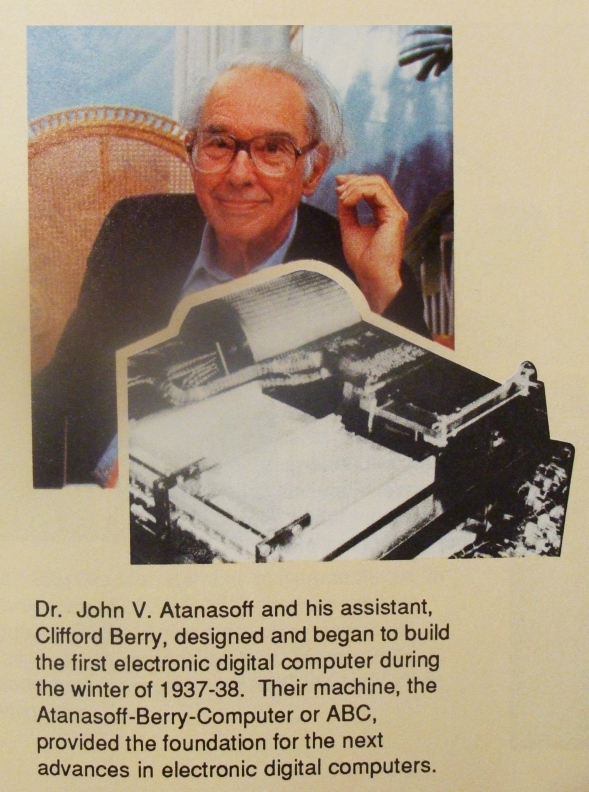

John Vincent Atanasoff, as a child, figured out how to use his father's slide rule. When he later graduated from the University of Florida with a nearly perfect grade point average in electrical engineering, he accepted a teaching post at Iowa State College. While at ISC, he earned a master's degree in mathematics and taught and thought. As an electrical engineer, mathematician, and physicist, Atanasoff’s thoughts turned to using electronics as a possible solution to problems of accuracy and speed in performing scientific calculations.
A great many of his thoughts dealt with how to compute a series of problems more rapidly than by hand. Atanasoff decided he would use electricity and electronics as the medium for his machine. In spite of custom, he would use base-two numbers for his computer. He would use condensors for memory and would use a regenerative or “jogging” process to avoid lapses that might be caused by leakage of power. He would compute by direct logical action and not by enumeration (counting) as used in existing analog caculating devices.
Atanasoff requested funds to hire an assistant and to build a prototype of his computer. He spent the next year making plans for his computer, and in March 1939 made a formal application to the college for funding a graduate assistant and for materials. Iowa State College approved a grant for $650, released in September.
Atanasoff hired Clifford Berry, and they began to construct the prototype for the world’s first electronic digital computer. Over the next months, the two mathematical geniuses labored together, each synergistically complementing the other's thoughts, creating a crude device that worked will enough to prove them right. The eleven-tube prototype was first demonstrated in October of 1939. A December demonstration prompted a grant for construction of the full-scale machine. The ABC was built and tested over the next two years.
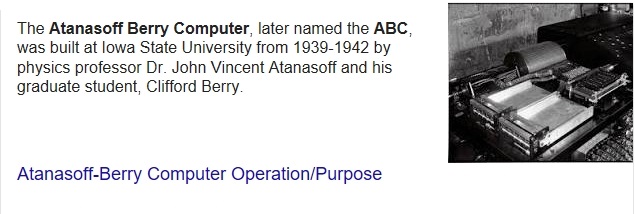
| In December 1939, Atanasoff and Berry demonstrated the machine to college officials, and were awarded additional funding to build the full-scale machine, which became known as the ABC. By late spring 1940, the machine was well on its way to completion, and they submitted a manuscript describing the details of the computer, both for obtaining a patent (which would never be filed by Iowa State College) and to apply for additional funding for refinement and perfection of the construction and operation features. As building of the machine continued, Clifford Berry wrote a manual for the ABC. | 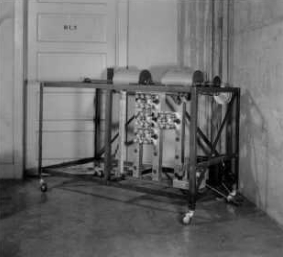 |
A January 15, 1941 story in the Des Moines Register announced the ABC as "an electrical computing machine" with more than 300 vacuum tubes that would "compute complicated algebraic equations" (but gave no precise technical description of the computer). The system weighed more than seven hundred pounds (320kg). It contained approximately 1 mile (1.6km) of wire, 280 dual-triode vacuum tumes, 31 thyratons, and was about the size of a desk.
In the summer of 1941, John Mauchly, a physicist at Ursinus College just north of Philadelphia, visited Atanasoff in Ames to see the ABC. At that time, Atanasoff revealed to Mauchly detailed drawings, plans, theories, and the working model of this first computer.
Mauchly quietly prepared his own version of the ABC, and then fashioned a deal with the U.S. Army to build his Electronic Numerical Integrator and Computer, the ENIAC, for use in computing ballistics trajectories. Since the ENIAC machine was considered top secret, Atanasoff could not gain access to either the device or the patents for which Mauchly was quick to file.
Years later, when Mauchly had become known as the father of the computer (due to ENIAC), other large computer companies contested the patents that Mauchly had sold to the Sperry Rand Corporation. Their motive was purely economic, as Sperry Rand planned to charge exorbitant fees for their use. The trial was one of the longest and costliest in history, with more that $5 million spent by Sperry Rand, and $3 million by the Honeywell Company, not counting court costs for a seven-year trial that yielded to over 20,000 pages of trial transcripts.
When the trial was over, Judge Earl Larson unequivocally found that Mauchly's ENIAC was "derived from Atanasoff and that the invention claimed in the Mauchly patent was derived from Atanasoff." Larson ruled that Mauchly's computer patent was invalid and Atanasoff clearly emerged the winner.
The ARPAnet, the predecessor of the Internet, was born in November 1969. In January 1983, ARPAnet shifted to the TCP/IP protocol, which to this date powers the modern Internet.
Tim Berners-Lee, a British scientist, invented the
World Wide Web (WWW) in 1989, while working at CERN. The web
was originally conceived and developed to meet the demand for automated
information-sharing between scientists in universities and institutes around
the world. The first web page went live on August 6,
1991. It was dedicated to information on the World Wide
Web project and was made by Tim Berners-Lee. It ran on a NeXT computer
at the European Organization for Nuclear Research, CERN.
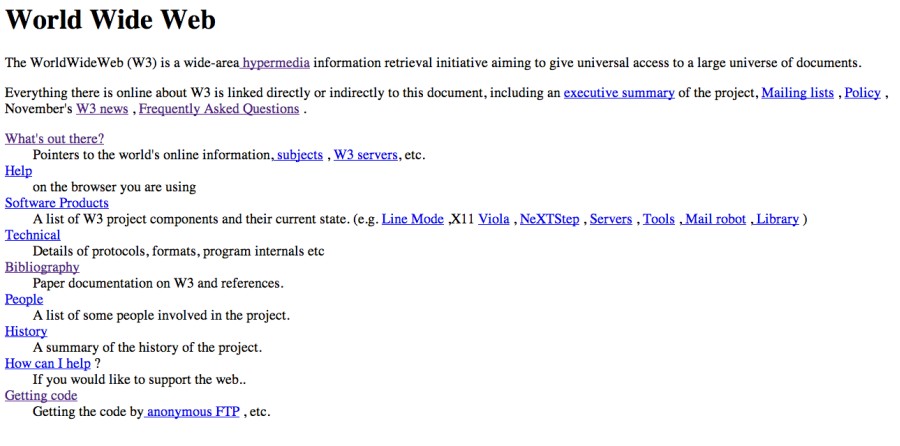
The first web page address was http://info.cern.ch/hypertext/WWW/TheProject.html. In 1992 Tim Berners-Lee created three things, giving birth to what we consider the Internet. The HTTP protocol, HTML, and the URL. His goal was to bring 'Hypertext' to life.
Hypertext Transfer Protocol Secure (https) is a combination of the Hypertext Transfer Protocol (HTTP) with the Secure Socket Layer (SSL)/Transport Layer Security (TLS) protocol. TLS is an authentication and security protocol widely implemented in browsers and Web servers.
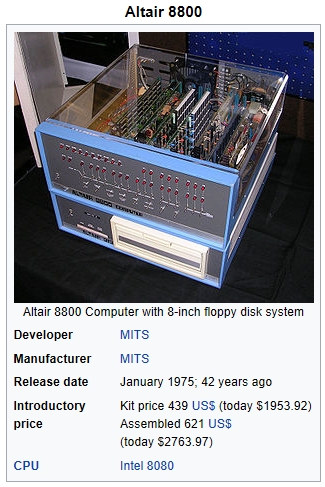
The Altair 8800 was a microcomputer designed in 1974 by MITS and based on the Intel 8080 CPU. Interest grew quickly after it was featured on the cover of the January 1975 issue (published in late November 1974) of Popular Electronics, and was sold by mail order through advertisements there, in Radio-Electronics, and in other hobbyist magazines.
The designers hoped to sell
a few hundred build-it-yourself kits to hobbyists, and were surprised when
they sold thousands in the first month. The Altair also appealed
to individuals and businesses that just wanted a computer and purchased
the assembled version. The Altair is widely recognized as the
spark that ignited the microcomputer revolution[5] as the first commercially
successful personal computer. The computer bus designed for
the Altair was to become a de facto standard in the form of the S-100 bus,
and the first programming language for the machine was Microsoft's founding
product, Altair BASIC.
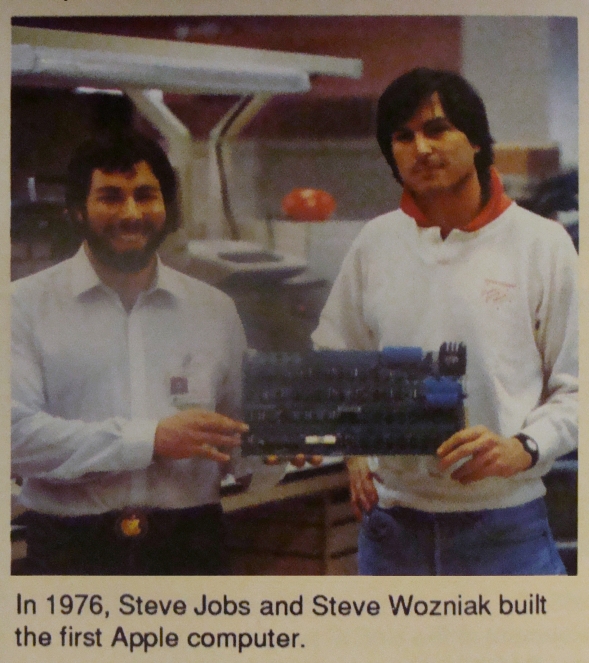
Steve Jobs and Steve Wozniak had withdrawn from Reed College and UC Berkeley respectively by 1975. Wozniak designed a video terminal that he could use to log on to the minicomputers at Call Computer. Alex Kamradt commissioned the design and sold a small number of them through his firm. Aside from their interest in up-to-date technology, the impetus for "the two Steves" seems to have had another source. In his essay From Satori to Silicon Valley (published 1986), cultural historian Theodore Roszak made the point that the Apple Computer emerged from within the West Coast counterculture and the need to produce print-outs, letter labels, and databases.
At the time, the only microcomputer CPUs generally available were the $179 Intel 8080, and the $170 Motorola 6800 ($757.00 in present-day terms). Wozniak preferred the 6800, but both were out of his price range. So he watched, and learned, and designed computers on paper, waiting for the day he could afford a CPU. When MOS Technology released its $20 ($84.00 in present-day terms) 6502 chip in 1976, Wozniak wrote a version of BASIC for it, then began to design a computer for it to run on. Wozniak completed the machine and took it to Homebrew Computer Club meetings to show it off. At the meeting, Wozniak met his old friend Jobs, who was interested in the commercial potential of the small hobby machines. Steve Jobs and Steve Wozniak had been friends for some time, having met in 1971, when their mutual friend, Bill Fernandez, introduced 21-year-old Wozniak to 16-year-old Jobs. They began their partnership when Wozniak, a talented, self-educated electronics engineer, began constructing boxes which enabled one to make long-distance phone calls at no cost, and sold several hundred models.
The machine had only a few notable features. One was the use of a TV as the display system, whereas many machines had no display at all. This was not like the displays of later machines, however; text was displayed at 60 characters per second. However, this was still faster than the teleprinters used on contemporary machines of that era. The Apple I also included bootstrap code on ROM, which made it easier to start up. Finally, at the insistence of Paul Terrell, Wozniak also designed a cassette interface for loading and saving programs, at the then-rapid pace of 1200 bit/s. Although the machine was fairly simple, it was nevertheless a masterpiece of design, using far fewer parts than anything in its class, and quickly earning Wozniak a reputation as a master designer.
Joined by another friend, Ronald Wayne, the three started to build the machines. Using a variety of methods, including borrowing space from friends and family, selling various prized items (like calculators and a VW bus) and scrounging, Jobs managed to secure the parts needed while Wozniak and Wayne assembled them. But the owner of the Byte Shop was expecting complete computers, not just printed circuit boards. The boards still being a product for the customers, Terrell still paid them. Eventually, 200 of the Apple I's were built.
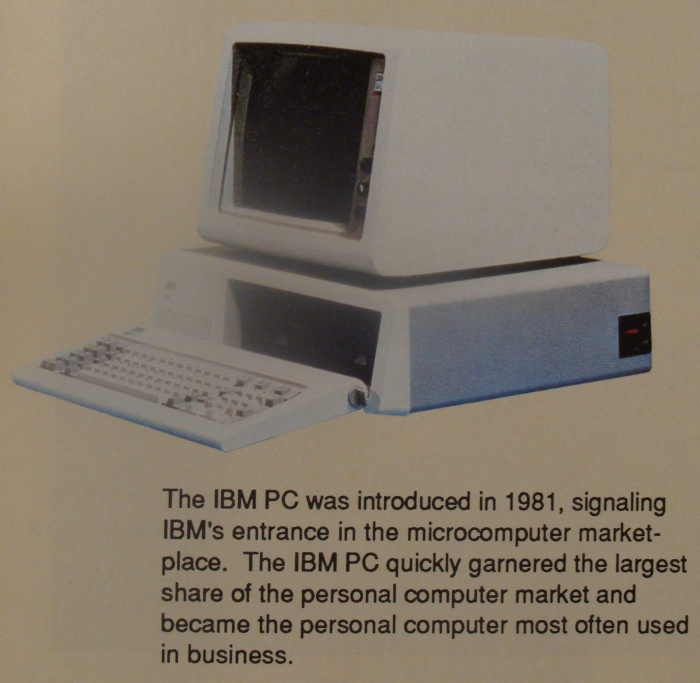
The IBM Personal Computer, commonly known as the IBM PC, is the original version and progenitor of the IBM PC compatible hardware platform. It was known as IBM model number 5150, and was introduced on August 12, 1981. It was created by a team of engineers and designers under the direction of Don Estridge of the IBM Entry Systems Division in Boca Raton, Florida.
The generic term "personal computer" was in use before 1981, applied as early as 1972 to the Xerox PARC's Alto, but because of the success of the IBM Personal Computer, the term "PC" came to mean more specifically, a desktop microcomputer compatible with IBM's PC products. Within a short time of the introduction, third-party suppliers of peripheral devices, expansion cards, and software proliferated; the influence of the IBM PC on the personal computer market was substantial in standardizing a platform for personal computers. IBM compatible became an important criterion for sales growth; only the Apple Macintosh family kept significant market share without compatibility with the IBM personal computer.
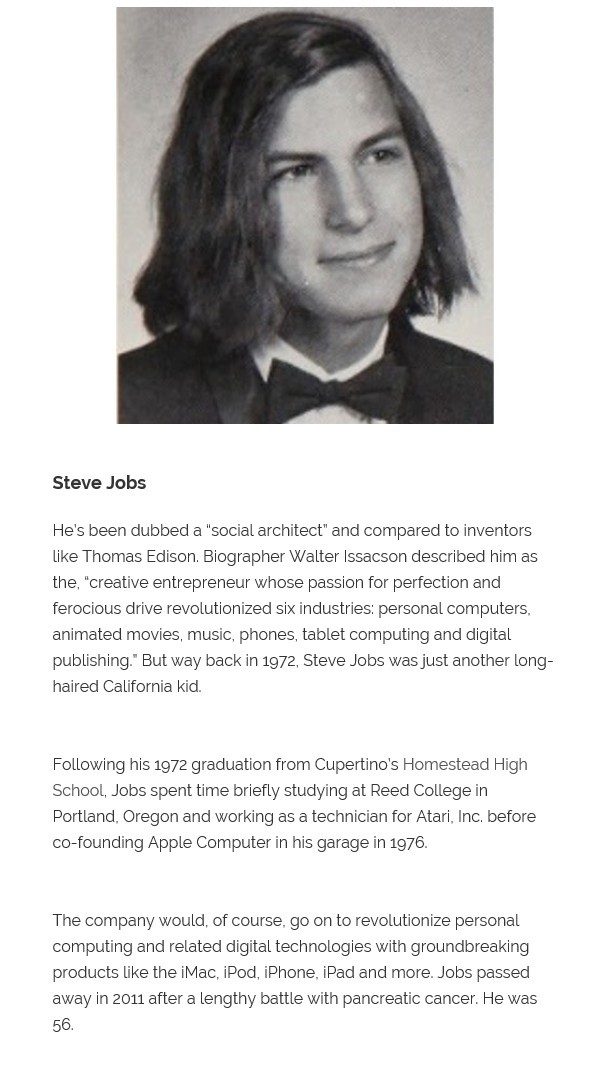
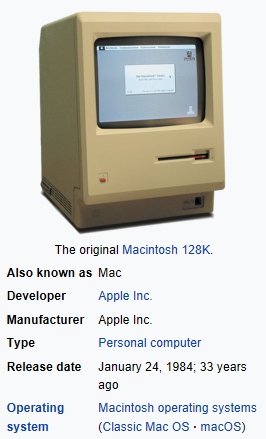 |
Steve Jobs introduced the original
Macintosh computer on January 24, 1984. This was the company's first
mass-market personal computer featuring an integral graphical user interface
and mouse. This first model was later renamed to "Macintosh
128k" for uniqueness amongst a populous family of subsequently updated
models which are also based on Apple's same proprietary architecture.
Since 1998, Apple has largely phased out the Macintosh name in favor of Mac, and the product family has been nicknamed "Mac" or "the Mac" since the development of the first model. |
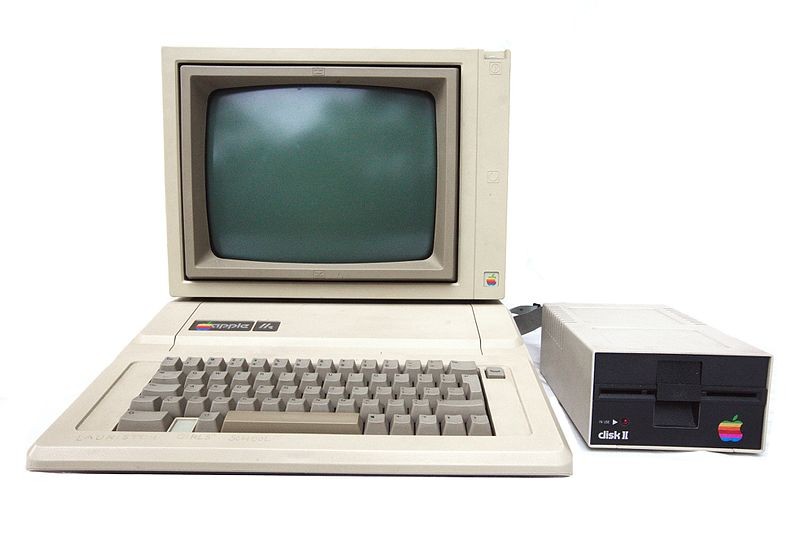
Steve Jobs said in an interview with the Computerworld Smithsonian Awards Program in 1995 during the NeXT Computer era, that "one of the things that built [the] Apple II was schools buying Apple IIs."
Following a failed effort in Congress to pass a massive tax credit in the waning days of the Carter administration to enable nationwide donations of computers, Apple turned to California. After the state's governor signed a bill in 1982 to grant a tax credit, the company donated Apple IIe computers to around 9,000 schools in its home state.
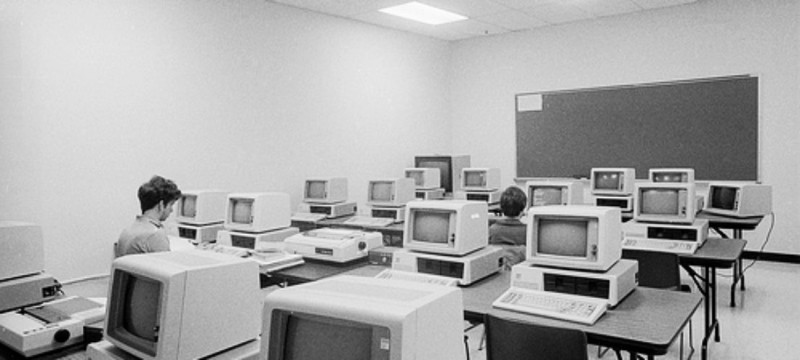
The proliferation of these computers in schools helped
Apple get an early foothold in the education market. Later in the Smithsonian
interview, Jobs said that "I've helped with more computers in more schools
than anybody else in the world," but noted that machines can't make as
much of an impact on students' lives as "a person," meaning a teacher or
parent, can.
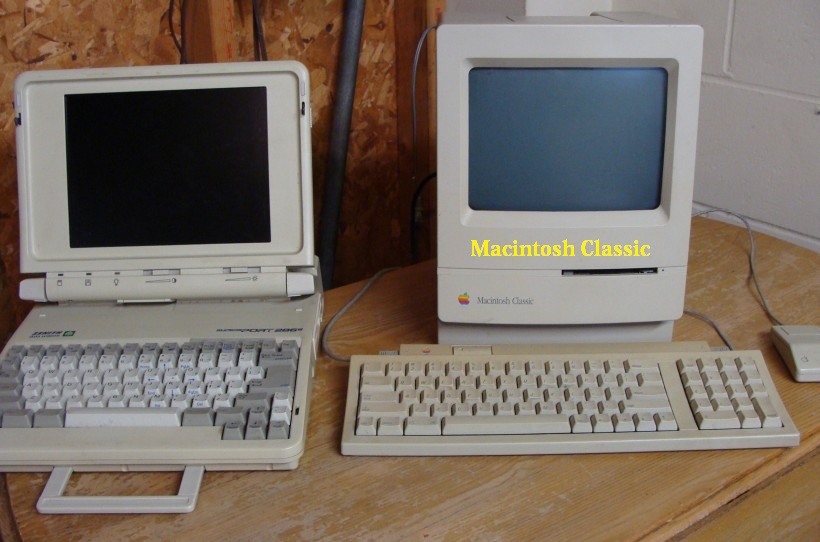
The Macintosh Classic, essentially a less expensive version of the Macintosh SE, was the least expensive Mac offered until early 2001.
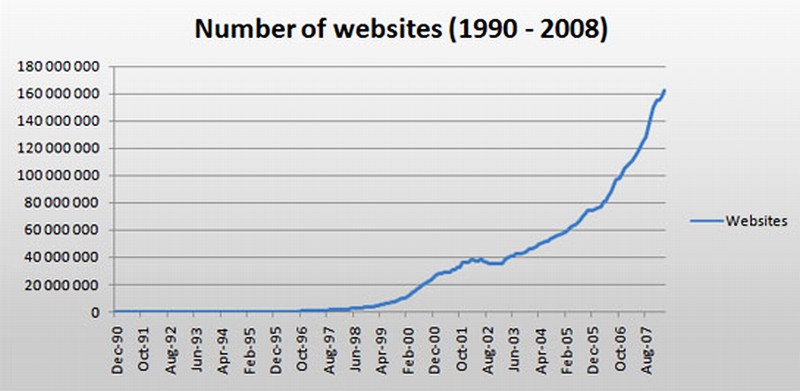
The computer legend who invented email has now died. The very first version of what would become known as email was invented in 1965 at Massachusetts Institute of Technology (MIT) as part of the university's Compatible Time-Sharing System, which allowed users to share files and messages on a central disk, logging in from remote terminals. Internet Hall of Famer Ray Tomlinson is no longer with us. Tomlinson was the man who basically invented email as we know it today, including making the choice to use the "@" sign in an email address. He was 75 when he died. Tomlinson invented email, a system where a user on one network could send a message to someone on another network, in 1971. He proceeded to win many awards over his lifetime for email. But he couldn't say what the first email ever sent actually said. When asked about it in an interview with the New York Times in 2009, Tomlinson explained, "I sent a number of test messages to myself from one machine to the other. The test messages were entirely forgettable and I have, therefore, forgotten them." On a recent Saturday, the man widely recognized as the grandfather of the internet, Vint Cerf, tweeted the news that Tomlinson had passed away.

Years ago we had Steve Jobs, Johnny Cash and Bob Hope.
These days, we have no jobs, no cash, and no hope.
Storage
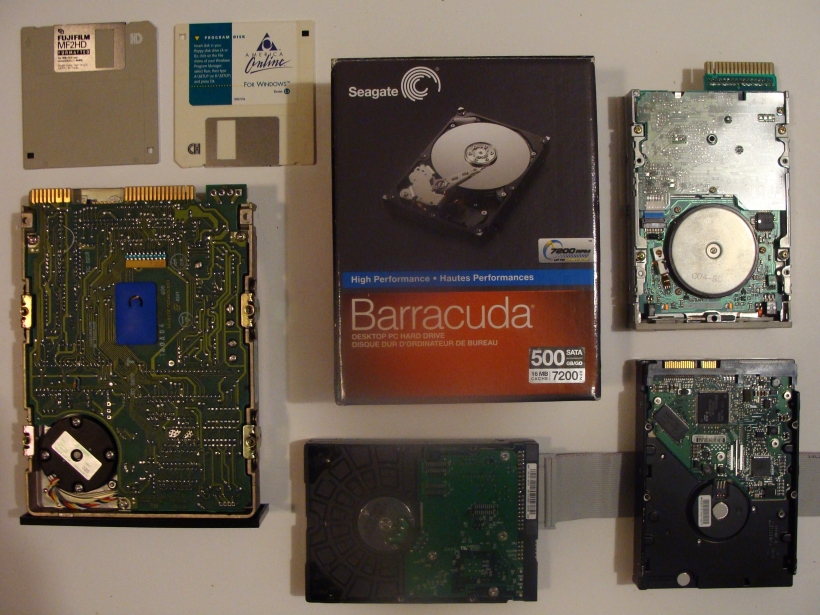
Hard Drives, Floppy Drives
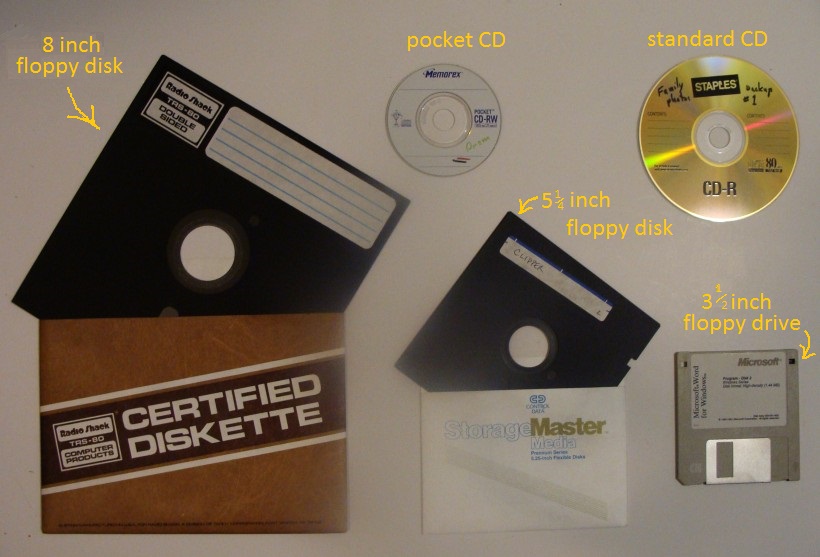
Storage disks
An early CD-ROM format was developed by Sony and Denon, introduced at a Japanese computer show in 1984.
(back)